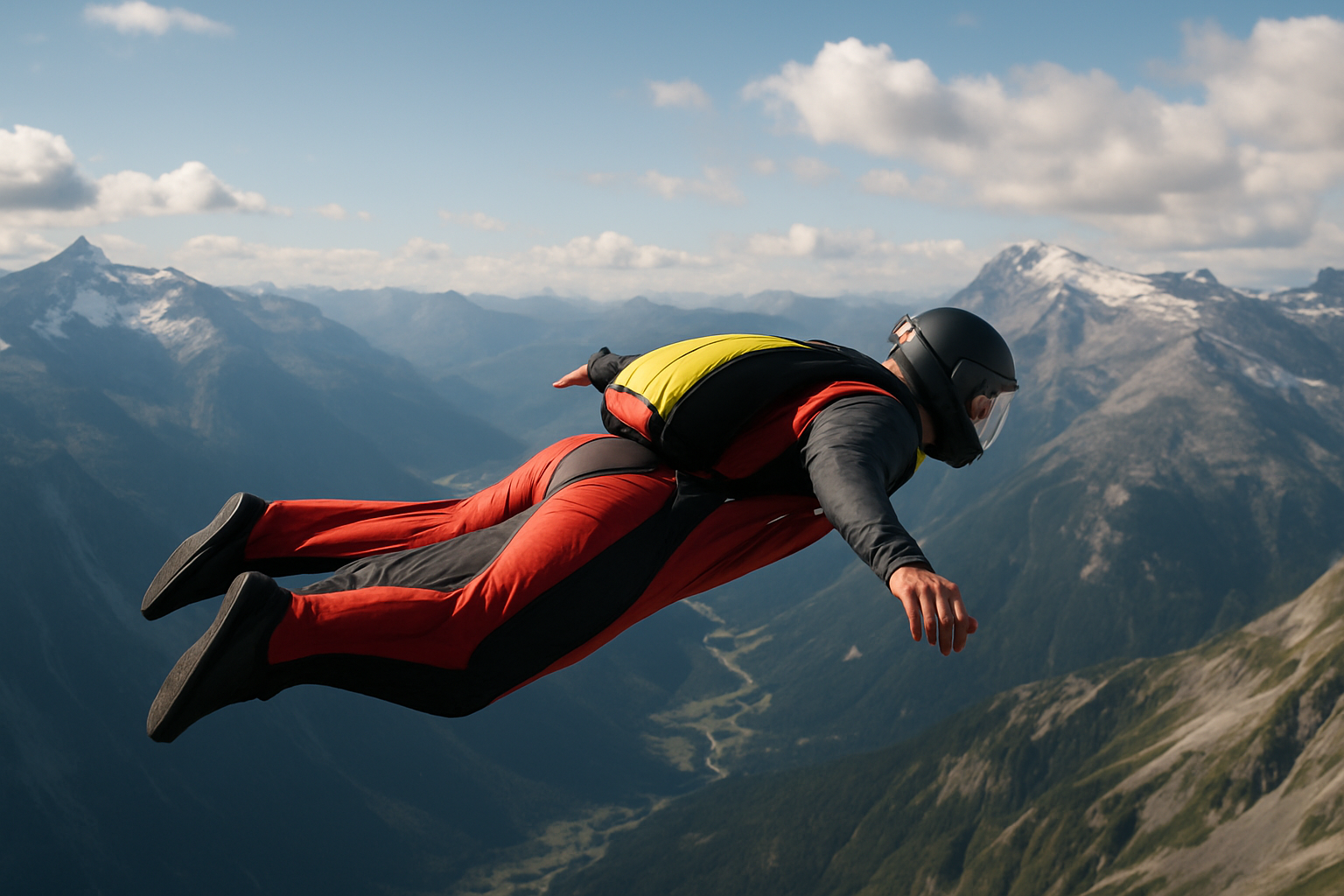Wingsuit Flying: Redefining the Limits of Human Flight
Soaring through the air at breakneck speeds, wingsuit flyers push the boundaries of human flight. This extreme sport combines the thrill of skydiving with the grace of bird-like gliding, allowing athletes to experience extended freefall and cover vast horizontal distances. As wingsuit technology advances and pilots become increasingly skilled, the sport continues to captivate both participants and spectators, challenging our perceptions of what's possible in the realm of aerial athletics.

It wasn’t until the late 1990s that modern wingsuit design began to take shape. Finnish skydiver Jari Kuosma and Croatian parachute designer Robert Pečnik collaborated to create the first commercially available wingsuit in 1999. Their design, which featured fabric membranes between the arms and legs, allowed for safer and more controlled gliding. This breakthrough reignited interest in the sport and paved the way for rapid advancements in wingsuit technology and technique.
The Science Behind Wingsuit Flight
At its core, wingsuit flying relies on the principles of aerodynamics to achieve lift and forward motion. The suit’s design creates an airfoil shape when the flyer assumes the correct body position, generating lift as air flows over and under the fabric membranes. This lift, combined with the flyer’s forward momentum, allows for extended gliding and reduced vertical descent rates.
Key factors affecting wingsuit performance include:
-
Aspect ratio: The ratio of wingspan to chord length, which influences glide efficiency.
-
Surface area: Larger surface areas generally provide more lift but can be harder to control.
-
Fabric permeability: Less permeable fabrics offer better lift but can be more challenging to fly.
-
Body position: Precise adjustments in arm and leg positioning allow flyers to control their speed and direction.
Modern wingsuits can achieve glide ratios of up to 3:1, meaning they can travel three feet horizontally for every foot of vertical descent. This allows skilled pilots to cover impressive distances and perform complex maneuvers during flight.
Training and Safety in Wingsuit Flying
Becoming a proficient wingsuit pilot requires extensive training and a strong foundation in skydiving. Most governing bodies, such as the United States Parachute Association (USPA), require skydivers to have completed a minimum of 200 freefall skydives before attempting wingsuit flight. This prerequisite ensures that pilots have developed the necessary skills in body control, altitude awareness, and emergency procedures.
The typical progression for aspiring wingsuit flyers includes:
-
Traditional skydiving training and experience
-
Specialized ground school for wingsuit theory and safety
-
Introductory flights with smaller, more manageable wingsuits
-
Gradual progression to larger, more advanced suits
Safety remains paramount in wingsuit flying, with pilots adhering to strict protocols and using specialized equipment. Modern wingsuits feature quick-release systems that allow for rapid suit removal in emergencies. Additionally, pilots carry two parachutes (main and reserve) and often use audible altimeters to maintain altitude awareness during flight.
Despite these precautions, wingsuit flying remains an inherently dangerous sport. Accidents can occur due to equipment failure, pilot error, or environmental factors such as unexpected weather changes or miscalculated flight paths. The sport’s proximity to terrain during some flights adds an extra layer of risk, requiring pilots to maintain constant vigilance and precise control.
Competitive Wingsuit Flying
As wingsuit technology and pilot skills have evolved, competitive events have emerged to showcase the sport’s capabilities. The Fédération Aéronautique Internationale (FAI) recognizes several disciplines within wingsuit flying competitions:
-
Performance Flying: Pilots compete to achieve the best scores in distance, speed, and time aloft.
-
Acrobatic Flying: Teams or individuals perform choreographed routines, judged on technicality and artistic merit.
-
Wingsuit Race: Pilots race against each other through a predetermined course.
These competitions have helped push the boundaries of what’s possible in wingsuit flying, with records constantly being broken. For example, the current world record for horizontal distance in a wingsuit flight stands at an impressive 32.5 kilometers, set by Kyle Lobpries in 2021.
Technological Advancements in Wingsuit Design
The rapid progression of wingsuit flying can be largely attributed to continuous improvements in suit design and materials. Modern wingsuits are a far cry from the primitive fabric wings of early pioneers, incorporating cutting-edge technologies to enhance performance and safety.
Some notable advancements include:
-
Computer-aided design (CAD): Allowing for precise optimization of suit geometry and aerodynamics.
-
Wind tunnel testing: Enabling designers to refine suit performance in controlled environments.
-
Advanced materials: Incorporating lightweight, durable fabrics that maintain their shape during flight.
-
Modular designs: Allowing pilots to customize their suits for specific types of flights or competitions.
One particularly innovative development is the integration of inflatable cells within the wingsuit. These cells, which inflate during flight, help maintain the suit’s shape and improve overall performance. This technology has led to the creation of “high-performance” wingsuits that offer unprecedented glide ratios and maneuverability.
Environmental Considerations and Wingsuit Flying
As with many outdoor sports, wingsuit flying has faced scrutiny regarding its environmental impact. While the sport itself has a relatively low direct impact on the environment, concerns have been raised about the potential disturbance to wildlife, particularly in mountainous areas where proximity flying is popular.
To address these concerns, many wingsuit communities have adopted responsible flying practices, including:
-
Respecting wildlife habitats and avoiding flights during sensitive breeding seasons.
-
Collaborating with local environmental organizations to identify and protect vulnerable areas.
-
Promoting “leave no trace” principles among pilots and spectators.
-
Supporting conservation efforts in areas frequented by wingsuit flyers.
Additionally, some wingsuit pilots have leveraged their unique perspective to contribute to environmental research and conservation efforts. By equipping suits with cameras and sensors, pilots can help monitor hard-to-reach areas, track wildlife movements, and assess the impact of climate change on mountain ecosystems.
The Psychology of Wingsuit Flying
The mental aspects of wingsuit flying are as crucial as the physical skills required. Pilots must maintain intense focus, make split-second decisions, and manage fear in high-stress situations. This unique combination of mental challenges has attracted the attention of psychologists and neuroscientists studying risk-taking behavior and decision-making under pressure.
Research has shown that experienced wingsuit pilots often exhibit:
-
Enhanced spatial awareness and proprioception
-
Improved ability to process multiple streams of information simultaneously
-
Heightened emotional regulation and stress management skills
-
A recalibrated perception of risk and reward
These cognitive adaptations not only contribute to safer and more successful flights but also have potential applications in other high-stress professions, such as emergency response and military operations.
The Future of Wingsuit Flying
As wingsuit technology continues to advance and the sport gains broader recognition, several trends are shaping its future:
-
Virtual Reality Training: VR simulations are being developed to provide safer, more accessible training environments for aspiring wingsuit pilots.
-
Augmented Reality Displays: Heads-up displays integrated into helmets could provide real-time flight data, enhancing safety and performance.
-
Biomimetic Design: Researchers are exploring suit designs inspired by nature, such as birds and flying squirrels, to further improve aerodynamics and control.
-
Sustainable Materials: The development of eco-friendly, high-performance fabrics could reduce the sport’s environmental footprint.
-
Urban Wingsuiting: As cities grow vertically, some envision a future where specially designed urban courses could bring the sport to metropolitan areas.
The Cultural Impact of Wingsuit Flying
Beyond its athletic and technological aspects, wingsuit flying has made a significant impact on popular culture. The sport’s visually stunning nature and inherent drama have made it a favorite subject for filmmakers, advertisers, and social media content creators.
Wingsuit flying has been featured in:
-
Major motion pictures, often as part of elaborate action sequences
-
Documentary films exploring the psychology and lifestyle of extreme sports athletes
-
Viral videos showcasing breathtaking flights through narrow mountain passes or over scenic landscapes
-
Marketing campaigns for adventure brands and energy drinks
This exposure has helped bring wingsuit flying into the mainstream consciousness, inspiring a new generation of thrill-seekers and pushing the boundaries of what’s considered possible in human flight.
Ethical Considerations in Wingsuit Flying
As wingsuit flying continues to evolve, it faces several ethical challenges that the community must address:
-
Risk vs. Reward: The sport’s high-risk nature raises questions about the ethics of pursuing such dangerous activities, particularly when accidents can impact rescue personnel and local communities.
-
Access and Regulation: As the sport grows, there’s ongoing debate about how to balance access to flying locations with the need for safety regulations and environmental protections.
-
Media Responsibility: The spectacular nature of wingsuit videos can sometimes glamorize the sport’s dangers, potentially encouraging unprepared individuals to attempt risky flights.
-
Commercial Pressures: As wingsuit flying becomes more commercialized, there’s concern about the potential for sponsors or event organizers to push pilots beyond safe limits for the sake of spectacle.
-
Technology Dependence: The increasing reliance on advanced technology in wingsuit design raises questions about the sport’s accessibility and the potential for technological failures to lead to accidents.
The Global Wingsuit Community
Despite its extreme nature, wingsuit flying has fostered a tight-knit global community. This network of pilots, designers, and enthusiasts plays a crucial role in advancing the sport through:
-
Knowledge Sharing: Experienced pilots mentor newcomers, sharing tips and techniques to improve safety and performance.
-
Collaborative Innovation: Pilots often work closely with suit designers to test and refine new technologies.
-
Safety Advocacy: The community actively promotes safe flying practices and works to develop standardized training protocols.
-
Conservation Efforts: Many wingsuit pilots are passionate about preserving the natural environments they fly in, leading to collaborative conservation projects.
-
Cultural Exchange: International wingsuit events bring together pilots from diverse backgrounds, fostering cross-cultural understanding and friendship.
This sense of community not only enhances the sport’s development but also provides a support network for pilots dealing with the physical and emotional challenges of such a high-risk activity.
Conclusion
Wingsuit flying represents a unique intersection of human ambition, technological innovation, and the primal desire for flight. As the sport continues to evolve, it challenges our understanding of human capabilities and pushes the boundaries of aerial athletics. While the risks involved cannot be ignored, the continued advancement in safety measures, training techniques, and suit design suggests a promising future for this extreme sport.
From its humble beginnings to its current status as a recognized competitive discipline, wingsuit flying has come a long way. It stands as a testament to human ingenuity and the relentless pursuit of new frontiers in sports and technology. As we look to the future, wingsuit flying is poised to soar to even greater heights, inspiring athletes, innovators, and dreamers alike to push the limits of what’s possible in the realm of human flight.





